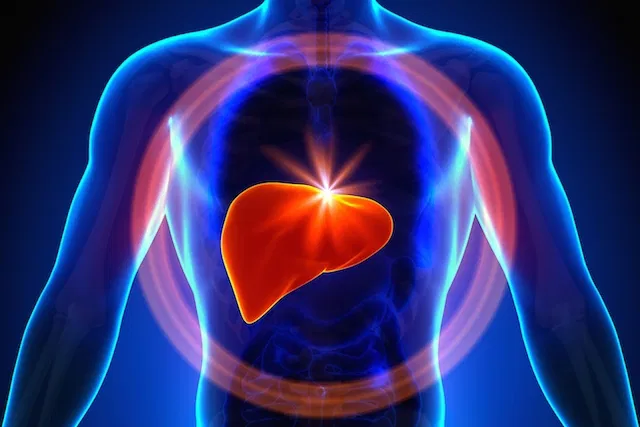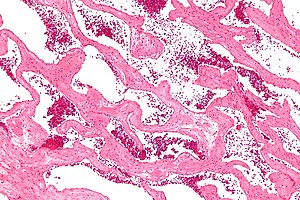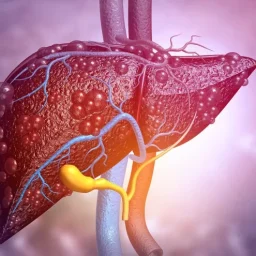
1. Large Liver Hemangiomas Causing Symptoms
One of the primary reasons for considering surgery in the case of liver hemangiomas is the size of the tumor. Most hemangiomas are small and remain asymptomatic, but when the hemangioma grows large, it can exert pressure on surrounding organs and tissues, leading to discomfort and other symptoms.
Larger hemangiomas, particularly those greater than 5 cm, are more likely to cause abdominal pain, bloating, a sense of fullness, or discomfort. When a liver hemangioma grows large enough to cause these symptoms, it may significantly affect a person’s quality of life. In cases where conservative measures such as pain management or monitoring are insufficient, surgical removal may be considered to alleviate symptoms and improve the patient’s comfort.
Hemangiomas larger than 10 cm are more likely to cause significant pain or discomfort. The decision to proceed with surgery will depend on the patient’s symptoms and the potential impact on daily life.
2. Risk of Rupture

Though rare, one of the most concerning complications of liver hemangiomas is the risk of rupture. Hemangiomas are composed of fragile blood vessels, and in larger hemangiomas, the vessels may become increasingly prone to rupture. If a rupture occurs, it can lead to significant internal bleeding, which may require emergency medical intervention.
The risk of rupture increases with the size of the hemangioma, particularly if it grows rapidly or is located near critical structures in the liver. If a liver hemangioma is large or shows signs of rapid growth, surgery may be considered to prevent rupture and the subsequent life-threatening bleeding that can occur. In some cases, the rupture may be difficult to predict, and preventative surgery may be the best option to avoid a medical emergency.
3. Chronic or Severe Pain
While mild abdominal discomfort may occasionally accompany liver hemangiomas, chronic or severe pain is more concerning and may indicate that the hemangioma is pressing against other organs or the liver capsule itself. Persistent pain that does not respond to conservative treatments, such as medications or lifestyle changes, can be a significant reason for opting for surgical intervention.
Pain from a liver hemangioma can also occur if the hemangioma is causing stretching or inflammation of the liver capsule. This type of pain is often sharp and can be located in the upper right side of the abdomen, where the liver is situated. In some cases, the pain may be severe enough to interfere with a person’s ability to carry out normal daily activities. If this occurs, surgery to remove the hemangioma may be necessary to relieve the pain and improve the patient’s quality of life.
4. Bleeding or Other Complications
A liver hemangioma can sometimes cause complications that require surgical treatment, including bleeding, bile duct obstruction, or other forms of liver dysfunction.
- Bleeding: While it is rare, large liver hemangiomas may rupture or leak blood into the abdominal cavity, leading to hemorrhage. This is a medical emergency and often requires surgery to stop the bleeding and remove the hemangioma.
- Obstruction: In some cases, a large hemangioma may press on the bile ducts or blood vessels in the liver, obstructing the flow of bile or blood. This can lead to jaundice (yellowing of the skin and eyes) or other signs of liver dysfunction. If these complications occur, surgery may be required to remove the tumor and restore normal liver function.
- Coexisting Liver Conditions: If a liver hemangioma is found alongside other liver conditions, such as cirrhosis or hepatitis, this may increase the likelihood of complications. For example, if a hemangioma is obstructing bile ducts in a liver already affected by cirrhosis, surgery may be necessary to remove the tumor and alleviate the obstruction.
5. Hemangiomas Located in Critical Areas

The location of a liver hemangioma can significantly influence the decision to perform surgery. Hemangiomas located near major blood vessels, bile ducts, or other critical structures within the liver may pose additional risks as they can affect blood flow or bile drainage. If a hemangioma is causing functional issues in these areas, surgery may be required to prevent further damage to the liver and surrounding organs.
Hemangiomas located in the central part of the liver or near the major blood vessels may be more challenging to remove surgically due to the risk of bleeding and injury to vital structures. In these cases, a careful evaluation of the risks and benefits will guide the decision-making process for surgical intervention.
6. Uncertainty About Diagnosis or Tumor Characteristics
In some cases, there may be uncertainty regarding the nature of the liver tumor. While most liver hemangiomas are benign, there is a small risk of malignancy, particularly if the tumor is atypical or behaves unusually. If imaging studies are inconclusive or if there is any suspicion that the tumor may be malignant, surgery may be recommended to obtain a definitive diagnosis and rule out other potential conditions, including liver cancer.
In situations where it is difficult to differentiate a liver hemangioma from other types of tumors, such as hepatocellular carcinoma (HCC), surgical exploration or biopsy may be necessary to confirm the diagnosis.
Surgical Options for Liver Hemangiomas
When surgery is required for a liver hemangioma, several options may be available, depending on the size, location, and complexity of the tumor.
1. Liver Resection
Liver resection is the most common surgical procedure used to remove liver hemangiomas. During this operation, a portion of the liver containing the hemangioma is surgically excised. Liver resection may be recommended when the hemangioma is causing significant symptoms or complications. This procedure is usually performed under general anesthesia and may require a hospital stay for recovery.
Liver resection is typically considered for hemangiomas that are localized and accessible for removal. The success of this procedure depends on factors such as the size of the hemangioma, its location, and the patient’s overall liver function.
2. Non-Surgical Approaches: Embolization and Ablation
In some cases, non-surgical approaches may be considered for treating liver hemangiomas. Two such methods are embolization and ablation.
- Embolization: This procedure involves blocking the blood supply to the hemangioma by inserting a catheter into the blood vessels that supply the tumor. By depriving the hemangioma of its blood flow, the tumor shrinks, and symptoms may improve.
- Ablation: Ablation therapies, such as radiofrequency ablation (RFA) or cryoablation, involve the use of heat or cold to destroy the hemangioma tissue. These treatments are typically less invasive than surgery and can be effective for smaller or symptomatic hemangiomas.
Both embolization and ablation are generally considered for patients who may not be ideal candidates for surgery or for those with smaller, well-defined hemangiomas that can be treated with these minimally invasive techniques.
3. Liver Transplantation (Rare)
In extreme cases where a liver hemangioma is associated with advanced liver disease, such as cirrhosis, and cannot be managed with other treatments, liver transplantation may be considered. However, this is a rare and extreme solution, as most liver hemangiomas do not cause enough damage to warrant a transplant.
Liver hemangiomas are generally benign and do not require treatment unless they grow large, cause symptoms, or lead to complications. Surgical intervention is typically considered only in rare cases where the hemangioma poses risks to the patient’s health, such as when it is causing severe pain, bleeding, obstruction, or is located in a critical area of the liver.
Patients with liver hemangiomas should work closely with their healthcare providers to determine the best course of action, whether it be surgery or other treatments, based on the size, location, and risk of complications associated with the tumor. With proper monitoring and management, most individuals with liver hemangiomas can live without significant health issues, but in certain cases, surgical intervention may be necessary to prevent complications and improve quality of life.





